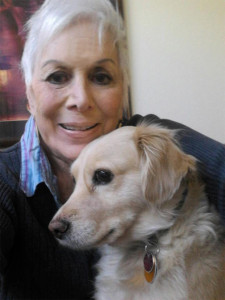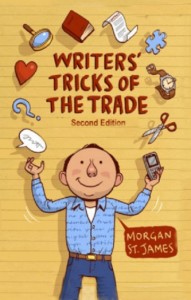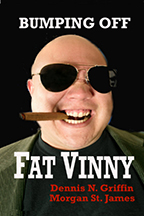by Morgan St. James, @MorganStJames
When I’m asked about writing with a co-author, two questions top the list every time. How do you write long distance? How do you work with another writer?
I find many people assume co-authors each write complete chapters or each write one of the main characters. For many co-authors that is true. Participants at conferences, writers’ groups and readings are always interested in my answer. My sister Phyllice Bradner was the first co-author I worked with. When we began to write together in the late 1990’s, both of us were published writers in other genres with our own credits and strengths. She lived in Alaska and I lived in Los Angeles. And, neither of us had tried our hand at fiction before.
Nevertheless, we launched the Silver Sisters Mysteries series. We make it known that our protagonists Goldie and Godiva, 50-year-old identical silver-haired Mae West lookalikes, are loosely based upon our own personalities.
What people may not be aware of is that Phyllice isn’t the only partner I write with now. Phyllice and I have written three books long distance with a fourth in the works. I’ve written three books with Dennis N. Griffin and one with Caroline Rowe, plus books I’ve written on my own. So, my answer covers not only how I write with Phyllice, but with other authors with whom I’ve collaborated. My stock answer when asked, “How do you write with a co-author?” is, “It should depend upon who you are writing with and what you are writing.”
When Phyllice and I began writing together in the late 90s, email wasn’t used by many individuals and we used faxes, which was daunting at best. Every edit had to be retyped. Sometimes we had marathon phone calls where one of us would enter edits on the manuscript, and we always had at least one session where we read chapters aloud to each other. Phone bills were huge because unlimited long distance plans were also just evolving. THANK GOODNESS FOR TODAY’S EMAIL AND UNLIMITED PHONE PLANS!
Unless you definitely want the reader to know where one author left off and the other took over, there are many ways to create a seamless manuscript that appears to have been written by a single author whether it is fiction or nonfiction.
Always remember that as similar as you may think you and your co-author are, each is an individual with a different pace, personality and expertise. By setting ground rules for the collaboration right at the beginning you can tap into your partner’s strengths and agree how to handle it if you disagree. Let’s face it. We all have our differences and that can lead to conflicts. Establishing fairly comprehensive guidelines in the beginning will help to avoid unpleasantness or inefficiency down the road. While it is easier if the authors are in the same locale, when Denny and I wrote “La Bella Mafia,” Bella Capo’s shocking true story, I was in Los Angeles, Denny was in Las Vegas and later New York, and Bella who was still in hiding, was in “parts unknown.” Despite the distances, the book is seamless.
Consider the writing style of your co-author.
For example, while I cut my teeth on magazine articles, having written many “how to” articles as well as some in-depth studies and a few true short stories that won awards, Phyllice received several Alaska Press Club awards and other accolades as a journalist and graphic designer, was the print specialist for the Alaska Department of Tourism and created award-winning political print pieces. Our expertise covered various facets of writing, none of which were fiction. We both had to learn the hard way that what was stock-in-trade for what we had published represented taboo for fiction in many cases. In the case of Denny, he began with writing fiction and evolved to becoming a true crime writer. With his background in law enforcement, he was always on the alert when it came to procedures depicted in the book. Caroline was not a writer, but went through the experience with me that triggered the concept for our book “Ripoff,” so she was an idea person.
These experiences led to being aware of what you do and don’t know and not being afraid to admit it. Also, when emails don’t seem to be doing the trick for something in particular, don’t hesitate to pick up the phone and call your co-author. Often more questions arise and the experience is different than banging the keys and hitting the SEND button.
My experience with Phyllice was unique.
Different writing styles and experiences can sometimes lead to conflict or disconnect. What happens when one churns out page after page while the other writes very slowly. In our case, I’m the one who writes very quickly and often click into “automatic writing,” while Phyllice massages every word and sentence to get it exactly right. My sense of humor is quite good, but hers is over-the-top.
That led to our first set of ground rules. Something easy to deal with when sending drafts and edits back and forth, now by email which is so much easier. The emerging writing team of St. James and Bradner, sisters who didn’t know each other very well when we began writing together because she moved to Alaska when she was only twenty, definitely possessed strengths in different areas. So we agreed after we our in person, Skype or telephone development meetings to plot the book, I would write the drafts and send them to her. She applied her editing skills and quirky sense of humor and sent them back. If I agreed, it went into the composite first draft manuscript. If not, we went through more rounds. My experiences with Denny and Caroline were different. Denny and I split writing chapters and were able to write in the same style. Then we had phone edit sessions. For “Ripoff,” I wrote the entire manuscript and Caroline fed in ideas.
This won’t work for everyone, and as I said I do write in different manners with different writing partners. Having identified these each partner’s traits, it isn’t hard to establish a framework for the long distance partnership.
Writing the first draft.
Often this process involves chapters going back and forth a few times. As each one is approved by both of you, paste it into the master. That way you can keep an eye on the running word count as it relates to your target word count for the whole book. Being aware of word counts can save a lot of cuts or padding later.
As a last step, schedule “out-loud” read-throughs and do them in person if possible. If it is possible one partner can travel to the city of the other and it becomes a little working vacation. If that is out of the question, with unlimited long distance on most plans it isn’t hard to have marathon phone sessions. Headphones in place or speakerphone activated, these conversations might last up to as long as five hours. Don’t set yourself a time limit for the call. If you are “on a roll” it helps to keep going. If you are tired, watching the hands on the clock until they reach the appointed time won’t result in your best effort. Reading out loud catches many things you don’t see while reading from the computer or a printout. You also catch more errors while reading a printout or print proof than on the computer.
How many drafts and how many times should you read it out loud?
Again, this depends upon who you are writing with and how much editing either of you do while the drafts are being developed. If you write with someone like my sister, often first drafts are as polished as fourth or fifth drafts of others. The test is when it sounds right and neither have objections or criticism. It is also helpful to enlist a friend who is a reader and will be very honest about their reactions. Ask them to read the first draft and the final draft. We tend to see everything through the eyes of an author when reading our own work, but readers will see different things and have different reactions.
When we are finally satisfied that we have polished the manuscript, and our editor is also satisfied, it’s time to either submit to your publisher or self-publish.
***
 A frequent panelist, moderator, speaker and radio talk show host, Morgan St. James also presents a variety of workshops and has written over 600 published articles for the Los Angeles and Las Vegas editions of Examiner.com. She publishes the free bi-monthly eZine “Writers’ Tricks of the Trade.”
A frequent panelist, moderator, speaker and radio talk show host, Morgan St. James also presents a variety of workshops and has written over 600 published articles for the Los Angeles and Las Vegas editions of Examiner.com. She publishes the free bi-monthly eZine “Writers’ Tricks of the Trade.”
With 14 books to her credit, in addition to writing her own novels like “Betrayed” and “Confessions of a Cougar,” as well as “Writers’ Tricks of the Trade: 39 Things You Need to Know About the ABCs of Writing Fiction,” a handbook for writers at all stages of their careers, Morgan and her sister Phyllice Bradner co-author the award-winning Silver Sisters Mystery series. “A Corpse in the Soup” was named Best Mystery Audio Book in 2007 by USA Book News, the 3rd book, “Vanishing Act in Vegas,” recently released, and they are currently working on the 4th book in the series, “Diamonds in the Dumpster.”
 She collaborated with true crime writer Dennis N. Griffin to write “La Bella Mafia,” the shocking but inspirational true story as told by Bella Capo, and the just released funny crime fiction “Bumping Off Fat Vinny.”
She collaborated with true crime writer Dennis N. Griffin to write “La Bella Mafia,” the shocking but inspirational true story as told by Bella Capo, and the just released funny crime fiction “Bumping Off Fat Vinny.”
Many of Morgan’s award-winning short stories appear in her single author anthology, “The MAFIA FUNERAL and Other Short Stories” available as an audio book in addition to the paperback and Kindle editions. She has also contributed stories to various anthologies featuring multiple authors including two Chicken Soup for the Soul books. Memberships include Greater Los Angeles Writers Society, Sisters in Crime, , Henderson Writers Group and Las Vegas Writers Group and she is on the board of Southern Nevada Writers.
For more information visit: www.morganstjames-author.com,
and http://writerstricksofthetrade.blogspot.com
Workshop Downloads:
Tips from writer @MorganStJames for writing with long distance partners. Share on X
You’d have to establish ground rules early.
I can only imagine the phone bills between you and your sister!
You bet. In the beginning we had to pay quite a bit for unlimited long distance. Fortunately now, with modern plans, there is no extra charge for unlimited long distance. In fact, I have Vonage and for the standard $36.00 a month charge for the service, I can call unlimited all over the world.
Elizabeth – Thanks for hosting Morgan.
Morgan – Thanks for sharing your co-authoring experience. It sounds as though the key really is not just setting the ground rules early, but also lots of honest communication. I give you both credit and I wish you success.
Yes, it is doing that and identifying the strengths of the other writing partner. My sister and I are working on the 4th Silver Sisters Mystery right now, “Diamonds in the Dumpster,” and she summed it up beautifully yesterday. When I write with her, I don’t edit anything I send her because I know she will and has a special touch. Here is what she said upon receiving Chapter 25. “Here is my edit of Chapter 25. There are lots of edits, but that’s the whole idea: You set the stage with the rough draft and I clean it up. A perfect symbiosis! See if you like my edits. –Sis”
It is different with Denny Griffin. We both write and edit for a result that is seamless writing in the final manuscript.
Hi Elizabeth and Morgan – you must have complete confidence in your own writing, and to have teamed up in the first place (even if one is your sister) a trust in yourself, as well as your writing partner … it would simply not be an option otherwise.
Mini differences can be got over … but that trust and confidence presumably over-rules all else before you even start, or in many cases think about it …
Congratulations – cheers Hilary
Good observation. I imagine if you don’t have trust in your own capabilities, edits or suggestions by the other party could be a blow to your ego. Unfortunately, in a situation like that the writer could get very defensive and not really see what the other one is saying. I have seen this happen in critique groups. All feedback should be considered, then you decide if it seems valid in your opinion. The arrangement I have with both Phyllice and Denny is that if one feels adamant about something, and the other is ambivalent, we should go with the idea that the adamant one favors. If it is equal, sometimes we ask for a third opinion from writer friends.
I’ve never written a fiction book with someone else. I had co-authors for my non-fiction book and we each had our own chapters.
That is another way of doing it. Because of the way Denny and I write together, we do that sometimes if we are up against a time constraint. For example, when we were writing La Bella Mafia I was diagnosed with breast cancer when we were about a third of the way through. Bella had gotten very close to me and I didn’t want to worry her, so Denny took over a good portion of the writing while I was on chemo and I gave him my feedback. Eventually, though, we did have to tell Bella what was happening. The project never got delayed and we went back to our normal routine when I was better. You cannot tell which chapters were mostly written by Denny. Sometimes I will give more input for female characters and Denny for males or anything that has to do with police procedure.
Fun and daunting! So crazy to think of doing that with a fax machine – nuts!! Brave ladies :)
The fax machine wasn’t the worst of it. Having to retype everything that was edited, and in the beginning the fax machines used the thermal paper roll. In this case, technology is great!
It sounds like ground rules are key. It’s amazing how many different ways there are to writing with a co-writer. I can imagine some of those phone bills, though. Email makes communication so much easier and quicker.
Also the best part about email is that you can cut and paste. I just discovered http://www.freeconferencecall.com which is another great tool that Denny Griffin turned me onto. You can record the conversations and play back and you can have as many people as you would like call in. Denny is acting as a consultant on a new book I’m doing because he’s swamped writing 4 books. Um, he beat me. I’m working on 3. But I recorded the whole conversation with Denny’s input and the woman whose memoir it is and was able to cull 3 chapters out of the conversation. Plus I have a record of everything.
Hi there, and thanks for an interesting post. You know, Google Docs (and “Google Sheets” — spread sheets) are now a wonderful way to work, even simultaneously, on the same manuscript with another writer or editor or other colleagues. They save automatically (within seconds), so you never need to worry about losing things. And you both can update and leave notes for each other. A great many joint writing projects are going on this way these days.
Here’s the info: https://www.google.com/docs/about/
Thanks again,
-p.
On Twitter: @Porter _Anderson
We must have been on the same wavelength. This morning I installed both Google Drive and Google Docs on my Tab3 and cellphone. Already had it on my laptop. The problem is I’m having a hard time accessing it on my phone. No problem on the Tab. This is also great for talks and readings if you don’t want to flip paper or hold a book the whole time. I haven’t used it for joint writing or editing, though. My sister is a little technophobic, so simple is better. Maybe the next project with Denny, though.
Congratulations! And this is a fascinating look into how two writers can work together. By the way, I’d love you to join the Boomer Lit group I founded on Goodreads, it’s a group aimed at silver-haired Baby Boomers just like your protagonists and yourselves! It’s not a self-promotion group (though you can list and pitch your book in specific threads set up for the purpose) , it’s also meant to be an advocacy group for Boomer authors, see this thread and go to the end of it (page 3):
https://www.goodreads.com/topic/show/1581352-boomer-lit-definition-re-visited-and-debated?comment=130700991&page=3#comment_form
The home page of the Boomer Lit group is this:
https://www.goodreads.com/group/show/81261-boomer-lit-novels-short-fiction-memoirs-and-more
Hope to see you there and anyone else who might be reading my comment! And again many thanks to Elizabeth for sharing this great post!
Thanks. I will definitely check it out. Have a wonderful day.